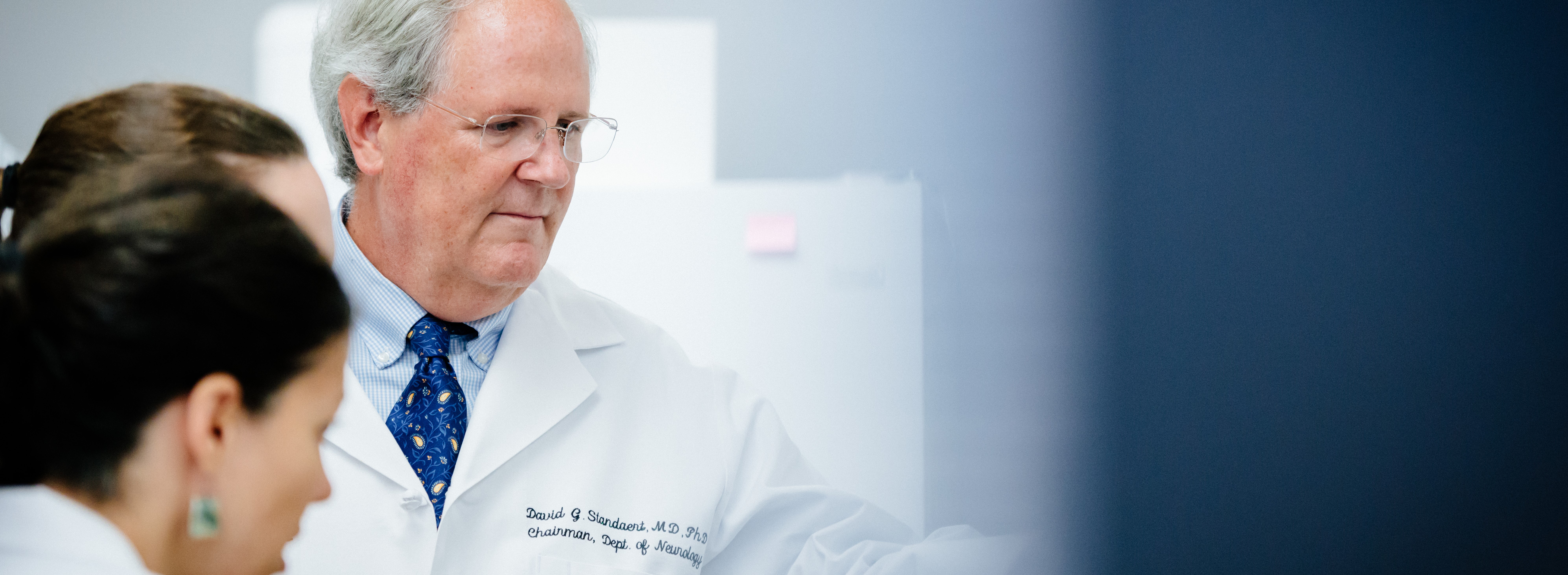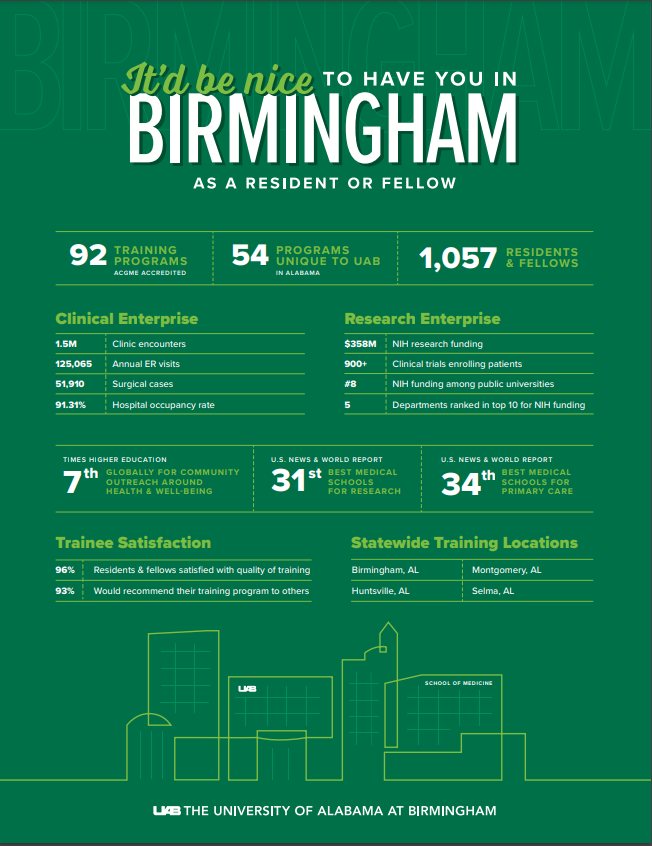Quick Links
Follow us on Social Media
Clinical Rotations
Inpatient Clinical Rotations
UAB neurology residents work in collaboration with various services in a team based approach. UAB neurology patient and family-centered care is centered on close collaboration with neurosurgery, interventional neuroradiology, physical medicine & rehabilitation, psychiatry, and other consulting services that offer highly specialized expertise in the care of complex critically ill patients. In addition, we work within a multidisciplinary team of nurses, case managers, nutritionists, occupational therapists, physical therapists, respiratory therapists, social workers and speech-language pathologists. Residents working in multidisciplinary teams provide high quality care to patients at UAB.
-
General Neurology
The general neurology inpatient service, commonly referred to as the Red team, is the heart of the inpatient experience during your residency training. Comprised of an attending, one senior neurology resident, 2 junior neurology residents, and several UAB medical students, the Red team takes care of all neurology inpatient needs except stroke and seizure monitoring unit patients. There is a different attending every 2 weeks, all of whom are eager and willing to teach.
Patients admitted to this service have complicated seizures, neurological diseases requiring procedures/infusions (such as IVIg or Plasma Exchange), tertiary referral diagnostic conundrums, and a host of other neurologic complaints. As with all inpatient services at UAB, there is exceptional support from ancillary medical professionals (nurses, pharmacy, PT/OT, speech, dietary, social workers) so that residents have ample time for patient care and reading time. Junior neurology residents have the autonomy to diagnose and treat their patients with guidance and close back up from the senior neurology resident and an always-available attending. -
Vascular Neurology
The Stroke team takes care of all patients with a suspected diagnosis of stroke, vasculitis, dissection, or other vascular problems involving the CNS. The team is comprised of an attending, senior resident, 1-2 junior residents, rotator (usually neurosurgery), APPs, and medical students. We have a dedicated stroke unit and a dedicated Neuro-ICU where we have ample support from critical care teams to help assist with ventilator management and severe medical complications. Our APPs on the service help us arrange disposition and cover stable patients who are awaiting placement or rehabilitation.
Our inpatient stroke service specializes in the prevention, diagnosis and treatment of stroke and stroke-related disorders through the Comprehensive Stroke Research Center, with a 24-7-365 stroke team and Neuro-Endovascular Interventional Service, pre-hospital notification from Birmingham Regional EMS paramedics (BREMSS), and Level I UAB Emergency Department.
The hospital-wide “Code Stroke” system that is activated in the event of acute neurologic deficits that are suspicious for stroke. This ensures that radiology is ready and waiting for the patient’s STAT critical vascular imaging. The CODE Stroke activation alerts the stroke attending, vascular neurology fellow, residents, pharmacists, stroke advanced practice providers and neurovascular ultrasonographer simultaneously. We have a very active Code Stroke program that treats more than 200 patients treated with advanced acute stroke therapies including thrombolysis and thrombectomy. Our residents are very comfortable and confident in making acute interventional decisions for stroke patients. -
Neurocritical Care
Third year residents complete 1 month dedicated to neurocritical care. The UAB NICU is an open ICU, and while residents gain exposure while on other inpatient services, this rotation allows for neurocritical care to be the primary focus. Residents will co-manage patients on the general neurology services, stroke service, neurosurgical services, and trauma patients under NICU trained faculty.
-
Epilepsy Monitoring Unit (EMU) and Long-Term EEG
All our residents complete 1-2 months of EMU coverage. Much of the resident’s time during this rotation is spent on the inpatient epilepsy service, which includes a 10-bed video EEG monitoring unit. State-of-the-art facilities and equipment are available for diagnostic studies and treatment. Intracranial electrode implantation, cortical stimulation studies, specialized EEG procedures, and a full range of conventional and special tests are available.
Common reasons for admission to the EMU include the following:- Classification of seizure type such as epileptic vs nonepileptic or partial vs generalized
- Significant medication changes
- Pre-surgical evaluation that includes any combination of MRI with 3.0T scanner, MEG scanning, PET or SPECT scanning, epidural/subdural electrode recording, neuropsychological evaluation and WADA testing. This patient cohort is seen in collaboration with neurosurgeons specializing in epilepsy surgery.
-
Birmingham VA Medical Center Neurology Service
The VA Neurology service covers both neurology inpatients and consults at the Birmingham VA Medical Center. The inpatient service includes a devoted 24-hour EEG monitoring bed for epilepsy patients. The service is staffed by a VA neurology attending, a senior neurology resident, a PGY2 neurology resident, possibly one or two rotating residents (often psychiatry), and medical students.
Residents will also assist with VA subspecialty clinics throughout their week on VA service. This exposes residents to management of acute and chronic neurological problems and procedures including EMG/NCS, Botox, and nerve blocks in the outpatient setting. -
Neurology Consult Service
There are two Neurology consult services, referred to as the Green and Gold teams, which alternate call days and see all inpatient neurological consults at UAB. The Gold team consists of an attending, a senior neurology resident, a junior neurology resident, one to three rotating residents, and medical students. The Gold team is highly focused on education of both residents and medical students. The Green team consists of an attending, a PGY-3 neurology resident, and several APPs. This team allows the PGY-3 residents graduated responsibility of managing a neurology inpatient team.
On consults, residents see a wide spectrum of neurological complications of medical and surgical diseases. Given that UAB is one of the largest hospitals in the nation with a complete range of primary and specialty care specialties, residents’ experience on the consult services is extensive. Residents become very comfortable with neurological consults of any kind due to the volume and diversity of the patient population at UAB. -
Night Float
In house call is limited to the PGY-2 year and primarily consists of one month of night float. During this month, residents take in house call at UAB University Hospital Monday through Friday for 4 weeks; however, backup from the senior resident and attending is always available. Prior to night float rotation, all residents complete emergency department and EEG rotations that prepare them well for independent calls as well as interpreting EEGs for overnight emergencies. All didactics are recorded and available to allow for continued education during this month.
-
University Emergency Department Neurology Consult Service
The UAB Hospital Emergency Department is Alabama’s busiest and only Level-I trauma ED. The ED has over 60 treatment rooms and 2 high-speed, multi-detector CT scanners. During PGY-2 through PGY-4 years, residents spend two months triaging patients directly from the ED. Residents respond to Code Strokes and neurology consults for patients presenting to the ED. This affords residents the opportunity to be the first neurologist to evaluate patients who present with a wide range of neurological symptoms.
Outpatient Clinical Rotations
Continuity Clinics, The Kirklin Clinic, Subspecialty Clinics, Neuromuscular Clinics and EMG Laboratory, Neuro-Ophthalmology Clinic, Epilepsy/Oncology Rotation
Other Rotations
Neuropathology, Psychiatry, Pediatric Neurology, Electives
Benefits
-
Salary
PGY 1
PGY 2
PGY 3
PGY 4
$54,214
$55,992
$57,506
$59,941
-
Stipend
This money may be used for books, tools, educational material, travel to meetings, and licensing fees.
PGY 1
PGY 2
PGY 3
PGY 4
$500
$1,000
$1,000
$1,000
-
Residents' Library
Used almost exclusively by the residents, this formal library with journals, books and computers is a great place to read or work on research projects or chat with a fellow resident about a project. Residents use the library frequently to do some extra reading or as a quiet place to relax during the day. You will find this space to be very quiet, relaxing and useful throughout your years at UAB.
-
Perks
- Parking
- Pagers, lab coats, and scrubs
- ACLS/BCLS Certification and Re-Certification
- Access to UpToDate and most medical journals from off campus through Lister Hill library login
- 60% discount in UAB hospital cafeteria
- Lunch at daily noon conferences
- American Academy of Neurology membership (begins PGY2 year)
- Subscription to AAN journals including Green Journal, Continuum and also to Archives of Neurology and Annals of Neurology
- Counseling Services through the UAB Faculty and Staff Assistance Program
- Remote access to the UAB Electronic Medical Record
- Professional Liability Insurance
- Group Term Life Insurance
- Long-Term Disability Insurance
- Accidental Death and dismemberment Insurance
- 403(b) and 457(b) Retirement Plans (optional)
- Flexible Spending Account
- Travel to a national/international meeting is reimbursed if the resident is presenting as first author on a paper or poster
-
Other Benefits
- Low cost health, dental and vision insurance
- Sick leave
- Family leave
- 3 weeks of paid vacation annually
- Low cost recreational facility membership
For more details about UAB employee benefits, please see the UAB Human Resources Benefits website.Also visit the Graduate Medical Education website for details about benefits the hospital provide to residents.
-
Moonlighting
The neurology house staff has a policy outlining moonlighting regulations. Moonlighting is allowed because of the tremendous financial burden facing today's resident but we emphasize our residents need to have ample time for reading and other neurology activities.
Mentoring
Each resident is paired with a faculty member to establish a resident-mentor relationship. Residents meet with their mentor quarterly for advice regarding career development and any other interests or concerns.
Residents Library and Learning Resource Center
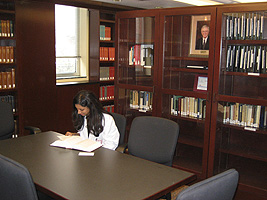 Neurology residents enjoy the newly built neurology library and learning resource center. Residents may study, read, relax, surf the Internet, and conduct a journal search in the library. There is a separate office inside the library where the chief residents may work.
Neurology residents enjoy the newly built neurology library and learning resource center. Residents may study, read, relax, surf the Internet, and conduct a journal search in the library. There is a separate office inside the library where the chief residents may work.
The spacious room features plush furniture, mahogany bookshelves, and five state-of-the-art computers. One of the computers is a complete media center, equipped with CD/DVD burners, printer, scanner, copier, etc., for building high-tech presentations.
The library has many neurology reference books and journals, in addition to the on-line research tools available. The glass showcase displays important historical neurology examination tools, texts, photographs, documents, and faculty publications such as research papers and books. This wonderful facility is a prime example of the department's commitment to the residents and their learning.
Lectures, Presentations, & Rounds
-
Weekly Conference Schedule
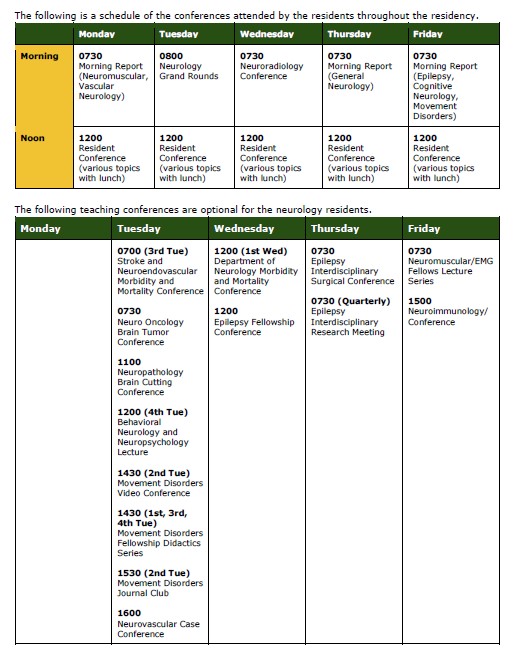
The above is a schedule of the conferences attended by the residents throughout residency. Click here to view the pdf of the schedule.
We have many, varied conferences available to residents throughout the year including:
- Professor Rounds (monthly)
- Neurovascular Conference (weekly)
- Neurophysiology Conference (weekly)
- Morbidity and Mortality Conference (every other month)
- Brain Tumor Board (weekly)
- Brain Cutting (weekly)
- Epilepsy Surgery Conference (as needed, often weekly)
- Neurobiology Lectures (varies widely)
- Pediatric Neurology Conference (bimonthly)
-
Neuroradiology
On Wednesday mornings, we hold 1-hour sessions with one of our neuroradiologists to discuss neuroimaging studies. During these morning reports, residents present cases to the neuroradiologist who then guides residents through the relevant imaging modalities on the studies performed on the patient, highlighting interesting or unusual findings.
-
Morning Reports
On Monday, Thursday, and Friday mornings, we hold 30 minute morning reports with an established faculty member. During these morning reports, residents present patients to an attending who then guides residents through the history, physical exam, imaging findings, differential diagnosis and appropriate workup and treatment.
These are instrumental in residents’ development of methodical approaches to patient care and evaluation. We present both typical general neurology patients and challenging diagnostic dilemmas in a very candid environment with residents, rotators, and students with input from everyone involved. This allows everyone to learn from each others’ patients and to extend the number of cases to which residents are exposed while in training.
-
Neuroscience Didactics Lecture Series
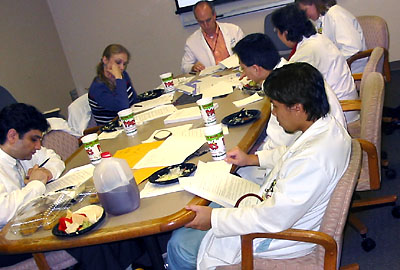
Every day from 12-1pm, residents attend Neuroscience Didactics Lecture Series with free lunch provided. The topics early in the academic year focus on emergent neurological problems, anatomy, and frequently encountered diagnoses in the clinic. In January and February the topics focus on topics that are heavy on the Residency In-Training Exam and on Neurology Board Exams. In March through June, lectures will cover extensive topics throughout neurology including a few talks focusing on financial planning, setting up a clinical practice, professional development, and various topics that are of interest to the residents. Each year, virtually all clinically relevant topics are covered at least once for the residents.
-
Neurology Grand Rounds
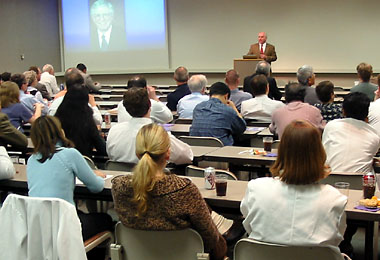
Neurology Grand Rounds is scheduled each Tuesday morning from 8:00-9:00am. This serves as a format from which neurologists at UAB and from the surrounding community can learn about developing research, novel treatment approaches, and other topics relating to neurology. From our senior residents to internationally acclaimed neurologists, the topics covered in our Grand Rounds are applicable to neurology and often represent future directions within our specialty.
-
Journal Club
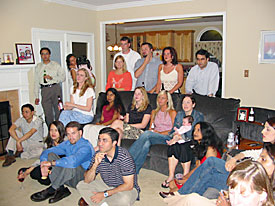
Under the supervision and direction of a chosen attending, each resident directs at least two journal clubs during their training. Typically, a recent article in a reputable journal is presented by the resident, followed by a discussion on critiques of the study design, applicability of the findings, and future study to strengthen or weaken the data presented. This lively discussion helps the residents to learn how to incorporate new information into their clinical practice.
Continuity Clinics
UAB Neurology Residents participate in two continuity clinics during their training. Both clinics follow the same framework in that residents take a history, examine the patient, develop an assessment and plan, and then report to an attending. This framework allows for a great deal of autonomy and helps sharpen residents’ clinical skills.
-
Birmingham VA Hospital Neurology Clinic
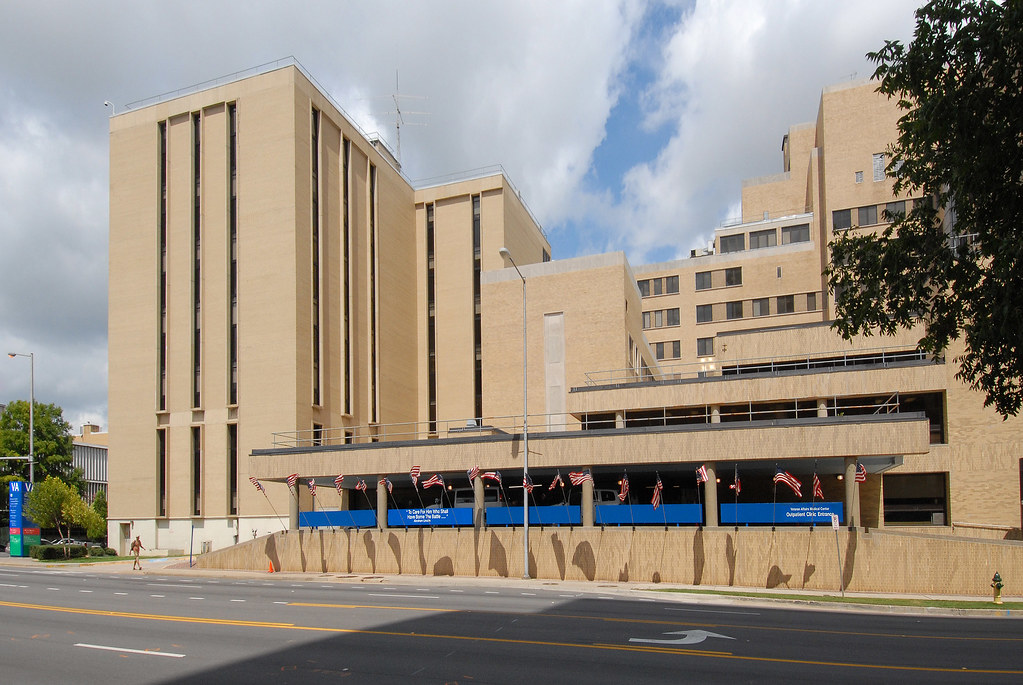 PGY-2 and PGY-3 residents have a half day of general neurology clinic at the VA on Thursday afternoons. PGY-4 residents have a half day of general neurology clinic on Friday morning. Residents on inpatient services are excused from their inpatient duties (except when on the Stroke team or night float) to attend their VA continuity clinic. On a typical day, neurology residents will see one to two new patients and then follow-ups from prior visits. The clinic is fairly busy as it is the only general neurology clinic in Alabama offered to Veterans with the VA Health System.
PGY-2 and PGY-3 residents have a half day of general neurology clinic at the VA on Thursday afternoons. PGY-4 residents have a half day of general neurology clinic on Friday morning. Residents on inpatient services are excused from their inpatient duties (except when on the Stroke team or night float) to attend their VA continuity clinic. On a typical day, neurology residents will see one to two new patients and then follow-ups from prior visits. The clinic is fairly busy as it is the only general neurology clinic in Alabama offered to Veterans with the VA Health System.
The upper level neurology resident performs EMGs two half-days per week. Besides attending a continuity clinic at the VA, residents also attend a VA staff attending subspecialty clinic five half-days per week. Because of this extra clinic, you will not have your Cooper Green continuity clinic during the VA rotation.
Because the VA Hospital is located just across the street from University Hospital, residents can easily and quickly walk across the street to attend the lectures and conferences. The VA service is a very realistic neurology experience because you will take care of inpatients, perform consults, read EEGs, perform EMGs, and go to clinics all in the same rotation! -
Cooper Green Neurology Clinic
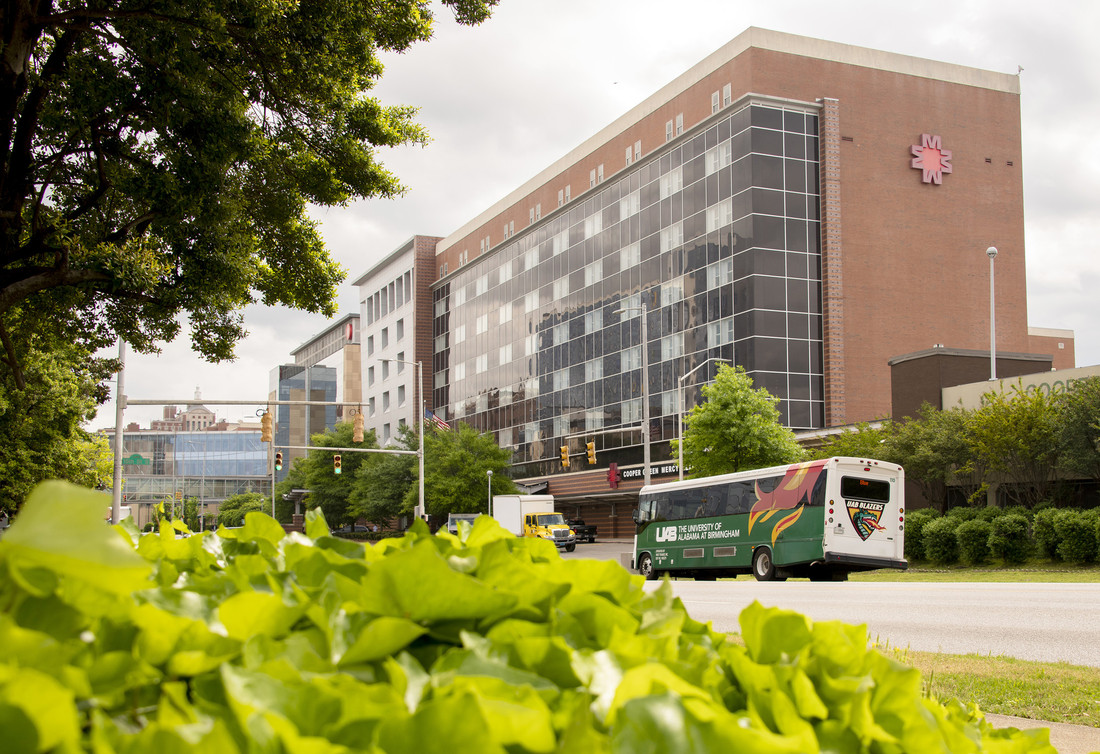 As a PGY-2, residents also participate in a half-day (Friday afternoon) of continuity clinic at Cooper Green Hospital. As with the VA, residents on inpatient services (except stroke and night float) are excused from inpatient duties to attend this continuity clinic. The patients cared for at Cooper green are usually disadvantaged. Because of this, patients present to clinic at different stages of common and uncommon neurological disorders.
As a PGY-2, residents also participate in a half-day (Friday afternoon) of continuity clinic at Cooper Green Hospital. As with the VA, residents on inpatient services (except stroke and night float) are excused from inpatient duties to attend this continuity clinic. The patients cared for at Cooper green are usually disadvantaged. Because of this, patients present to clinic at different stages of common and uncommon neurological disorders.
Research
The secret that UAB is a great place to train in neuroscience research is getting out. The Department of Neurology has active research across each of its divisions that span the bench-to-bedside spectrum. There are many more opportunities for scholarly investigation than there are residents to take them, and residents are encouraged to engage in their curiosities and scholarly pursuits in ways that are meaningful for them.
-
Comprehensive Stroke Center
Our Comprehensive Stroke Center in the Division of Cerebrovascular Disease is a member of the NIH StrokeNet. We regularly conduct clinical trials in the prevention and acute treatment of stroke. We have special expertise in neurosonology with one of the nation’s best trainers in the modality of cerebrovascular ultrasound. We also specialize in studies on recovery from injury at our adjoining Spain Rehabilitation Center and on the cognitive effects of cerebrovascular disease.
-
UAB Cannabidiol Program
The Division of Epilepsy and its NAEC Level 4 center has a long history in the research of seizure treatments. We were one of the original sites to pioneer the use of levetiracetam, and we continue to investigate novel pharmacotherapies for seizures, including through our UAB Cannabidiol Program. Our many surgical cases often employ novel technologies and protocols. We also have one of the few magnetoencephalography (MEG) and magnetic source imaging (MSI) laboratories.
-
Alzheimer’s Disease Center
The Division of Memory Disorders and Behavioral Neurology houses our NIA-funded Alzheimer’s Disease Center that focuses on Deep South disparities. We are part of many national collaborations including the Alzheimer’s Clinical Trial Consortium (ACTC), the Alzheimer’s Disease Neuroimaging Initiative (ADNI), the Alzheimer’s Disease Genetics Consortium (ADGC), the ARTFL-LEFFTDS Longitudinal Frontotemporal Lobar Degeneration (ALLFTD) research consortium, the Frontotemporal Dementia Prevention Initiative (FPI), the Alzheimer Disease Cooperative Study, and the Dominantly Inherited Alzheimer Network (DIAN).
-
NINDS Morris K. Udall Center of Excellence for Parkinson’s Disease Research
The Division of Movement Disorders is a stronghold for research from the leadership of President Ray Watts and Dr. David Standaert, the Department’s Chair. We are leaders in Parkinson’s disease research and are an American Parkinson Disease Association (APDA) Center for Advanced Research and a NINDS Morris K. Udall Center of Excellence for Parkinson’s Disease Research. We are also a Parkinson Study Group site and a Michael J. Fox Foundation Parkinson’s Progression Markers Initiative (PPMI) site. The Neuromodulation Laboratory is funded through the NIH BRAIN initiative to advance deep brain stimulation (DBS) technology. We also have a Huntington’s Disease Society of America Center of Excellence and are an Enroll-HD site.
-
Comprehensive Multiple Sclerosis Center
The Division of Neuroimmunology and Multiple Sclerosis has basic, translational and clinical research through its Comprehensive MS Center. Human studies in the MS Center are focused on how and why the disease begins, how it evolves over time, and patient outcomes. Discoveries made in the lab can validate new targets for drugs and other therapies. Physician-scientists at UAB have participated in clinical research to develop MS disease-modifying drugs since the pivotal study of interferon beta-1b in the late 1980s.
-
Shin J. Oh Muscle and Nerve Histopathology Laboratory
The Division of Neuromuscular Disease is home to the Shin J. Oh Muscle and Nerve Histopathology Laboratory and serves as a large biorepository for tissue-based research. Clinical investigation includes new therapies for treatment of Lambert-Eaton myasthenic syndrome, CIDP and myasthenia gravis.
-
O’Neal Comprehensive Cancer Center at UAB
In the O’Neal Comprehensive Cancer Center at UAB, an NCI-designated Comprehensive Cancer Center, is the Division of Neuro-Oncology. We are a leading member site for the New Approaches to Brain Tumor Therapy (NABTT), and we have bench-based and clinical studies ongoing.
Research efforts in the Department of Neurology are supported in the context of multiple, collaborations on campus, including the Center for Neurodegeneration and Experimental Therapeutics, the McKnight Brain Institute, the Comprehensive Neuroscience Center, the Civitan International Research Center, the UAB Nathan Shock Center of Excellence in the Basic Biology of Aging, the Department of Neurosurgery, the Department of Neurobiology, and the NIH-funded CTSA in the Center for Clinical and Translational Science. Also, nearly all laboratories are connected by bridges or are located across the street from the hospital complex.
Residents are encouraged to participate in research activities as early as PGY-2. Most PGY-3 and PGY-4 residents present abstracts at the AAN annual meeting or other subspecialty meetings. The Department is committed to support residents’ research efforts, and any resident who presents an abstract at a major neurology meeting will be reimbursed for travel, registration, and other expenses. For residents who commit to a physician-scientist training path, our NINDS R25 award supports development of a long-term project and affords an opportunity for six months protected time during residency and two years of research fellowship training after graduation.
We endeavor to support all of our residents’ endeavors, and the Department takes great pride in their research accomplishments, as we push the field of neurology forward, expand our understanding and improve patient care.
